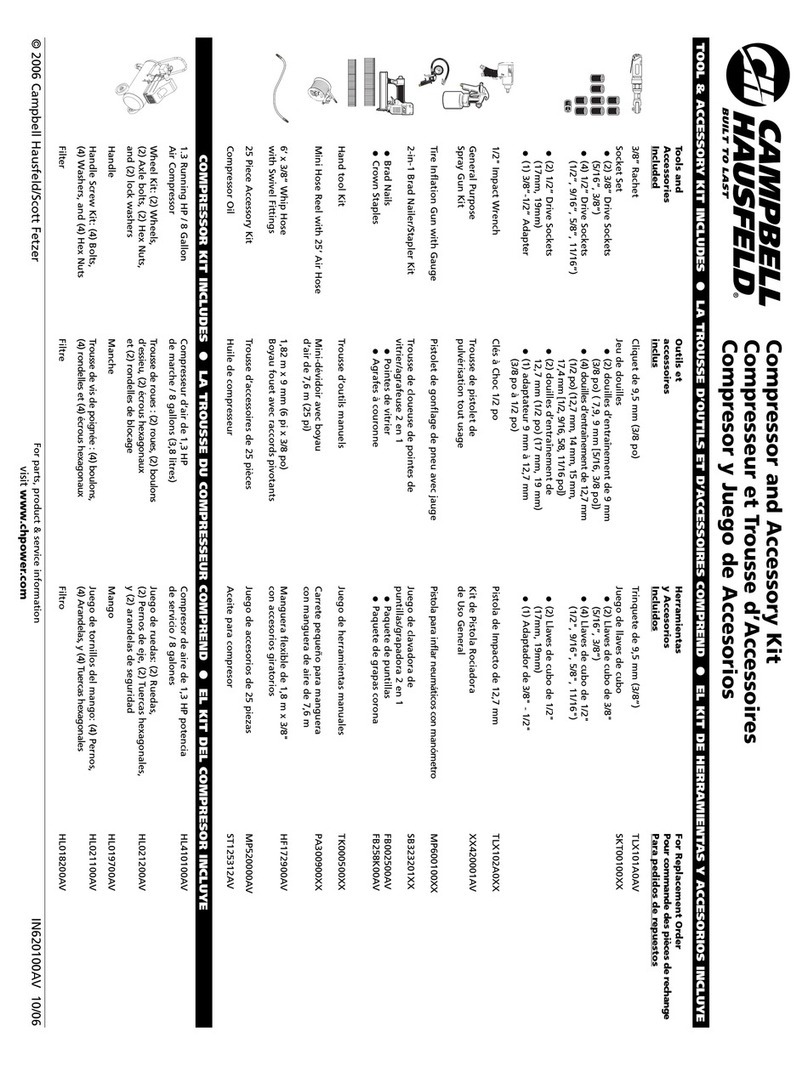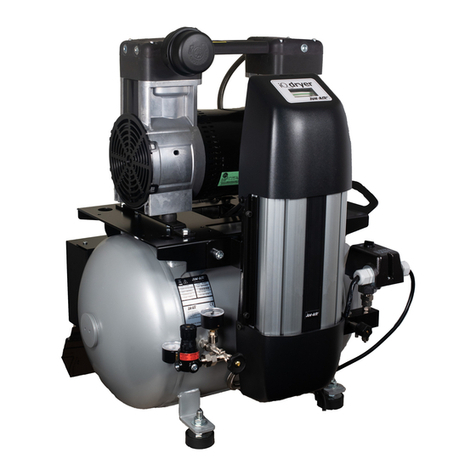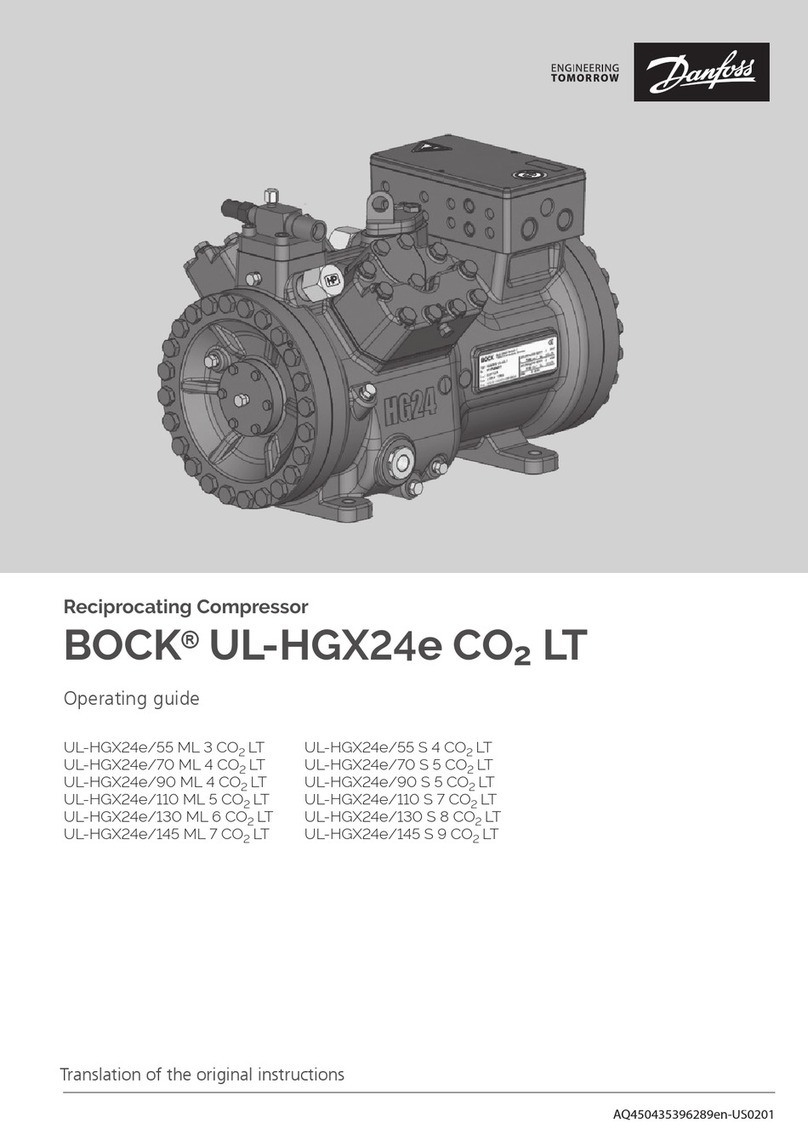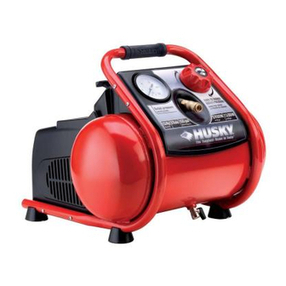J&E Hall HallScrew HSO 2000 Series User manual

HallScrew HSO 2000 Series
Open Drive Single Screw Compressors
HSO 2024, HSO 2028, HSO 2031 and HSO 2035
Manufactured after 06/03
Installation, Operation and
Maintenance Manual

HSO 2024 to HSO 2035 Installation, Operation and Maintenance Manual
Page 2 of 94 Publication 2-119 Issue 1.2 : 03/10
J & E Hall International
©
2010
All rights reserved. No part of this publication may be reproduced or transmitted in any form or by
any means, electronic or mechanical, including photocopying, recording or by any information
storage or retrieval system, without permission in writing from the copyright holder.
The copyright in this publication shall be and remain the sole property of J & E Hall International.

HSO 2024 to HSO 2035 Installation, Operation and Maintenance Manual
Issue 1.2 : 03/10 Publication 2-119 Page 3 of 94
Safety
In common with most other forms of mechanical and electrical
equipment, there are a number of potential hazards associated with
operating and servicing refrigeration plant.
In writing this instruction manual every emphasis has been given to safe
methods of working. These safety instructions are intended to draw
attention to the potential hazards that could be encountered during
installing, operating and maintaining the plant. At the same time, it
should be emphasised that these notes are not exhaustive, and are
principally intended to draw attention to the most important points; where
necessary, reference is made to other parts of the manual.
Please note that the installer is responsible for the correct installation of
equipment, and on completion, the owner and/or user are responsible for
safe operation and maintenance.
Personnel Permitted to Install, Commission and Maintain the Plant
It is essential that only authorised and competent personnel are allowed
to install, commission and maintain the plant. A permit to work system
should be introduced before commissioning begins, and should be
rigorously enforced thereafter.
Any person rendering assistance or under training must be supervised by
the authorised competent person who has responsibility for safety.
Personnel must be familiar with the plant’s construction, operation and
the hazards involved. All personnel should make a thorough study of
these instructions before undertaking installation, commissioning,
maintenance or repair procedures.
WARNING
A minimum of two personnel should always be present
when working on ammonia refrigeration plant.
Mechanical
Refrigeration compressors manufactured and/or supplied by J & E Hall
International must be operated within their design parameters, and
should never be used as vacuum pumps or for compressing air.
Personnel must not start the plant until they have taken steps to verify the
following:
•Guards on couplings, belt drives and fans are in place, and
other personnel are not in positions that might be hazardous
when the plant is in operation.
•The compressor discharge stop valve is fully open.
Parts of the plant, specifically the compressor, drive motor and discharge
line, are liable to be at temperatures high enough to cause a burn. A
‘cold’ burn can result from accidentally touching any part of the plant
containing oil at low temperature, or subcooled liquid refrigerant.
Personnel who stop the plant must be aware of the potential hazard if
pipeline stop valves are closed in such a manner as to trap cold liquid
refrigerant between valves. If this should accidentally occur, rising
ambient temperature will cause the liquid to expand and eventually
fracture the pipe or valves, etc.
Stop valves should be opened slowly to begin with and by a small
amount, say half a turn, before the valve is fully opened. This procedure
allows system temperatures and pressures to equalise gradually, so
reducing the risk of physical and/or thermal shock which might cause
damage.

HSO 2024 to HSO 2035 Installation, Operation and Maintenance Manual
Page 4 of 94 Publication 2-119 Issue 1.2 : 03/10
Examination of Pressure Systems
Within the United Kingdom, statutory regulations require the user to
prepare a ‘written scheme of examination’ to cover all parts of the plant
subject to pressure. It is a requirement that the scheme be introduced
before the plant is put into operation for the first time. If the plant is
modified, the written scheme of examination must be reviewed and
updated to incorporate these modifications.
Noise Hazard
The majority of noise emanating from refrigeration plant is produced by
the compressor(s), pump(s) and fan(s) and the motors which drive them.
While short term exposure to the typical average noise level which might
be encountered is unlikely to be detrimental to health, ear defenders
should be worn by those personnel who have to work near major sources
of noise. The type of ear defenders worn must not compromise the
wearing of other essential safety clothing, for example, goggles or a
respirator.
Electrical
Electrical wiring must be sized and installed to such a standard as to
meet the requirements of the national or local codes pertaining to the
area in which the installation is taking place.
The electrical power used in this equipment is at a voltage high enough to
endanger life. Before undertaking maintenance or repair procedures on
electrical equipment, personnel must isolate equipment from the electrical
supply and test to verify that isolation is complete. Precautions must be
taken to prevent circuits being inadvertently energised, for example,
withdraw the mains fuses, or, if this is not practicable, disconnect the
equipment from the supply before work commences.
If the supply cannot be disconnected or must remain connected to permit
functional testing, fault diagnosis and repair should only be undertaken by
persons who are aware of the hazard and who have taken adequate
precautions to avoid direct contact with dangerous voltages.
If electrical equipment overheats or a fault occurs, it must be
disconnected from the supply and allowed to cool. Overheating may
damage the insulation system, cables, mouldings, gaskets and seals.
The materials used in these components may contain complex organic
compounds which, when degraded by heat or electrical action, produce
chemical compounds in gaseous, liquid or solid forms. Many of these
gaseous and liquid product compounds are highly flammable and toxic.
If it is necessary to extinguish a fire in electrical equipment, follow the
advice given in the Fire Precautions Act 1971, ‘Guide to Fire Precautions
in Existing Places of Work that require a Fire Certificate’ available from
HMSO. Do not approach the equipment until the fire has been
extinguished and the equipment is cool.

HSO 2024 to HSO 2035 Installation, Operation and Maintenance Manual
Issue 1.2 : 03/10 Publication 2-119 Page 5 of 94
Lubricating Oils
Refrigeration oils are unlikely to present any significant health and safety
hazard provided they are used properly, and good standards of industrial
and personal hygiene are maintained. The following general precautions
are recommended:
•Avoid unnecessary handling of oily components. Use of a
barrier cream is recommended.
•Oils are potentially flammable and should be stored and
handled with this in mind. Rags or disposable ‘wipes’ used
for cleaning purposes should be kept well away from naked
flames and disposed of properly.
•Oil contained in the compressor lubrication system, oil
separator, oil filter etc, will remain hot enough to cause
burns for some time after the system has been shut down. If
it is necessary to open the system soon after the
compressor has stopped, to change the oil filter for example,
always allow long enough for the oil to cool down so that the
oil which is likely to escape is cool enough not to be a
danger (less than 35 °C is recommended).
Ammonia Refrigerant 717
Refrigeration systems contain liquid and vapour under pressure;
personnel should be aware of this fact at all times. Suitable precautions
must be taken to guard against the pressure hazard when opening any
part of the system.
Opening up part of the primary refrigeration circuit will necessitate the
loss of a certain amount of refrigerant to atmosphere. It is essential to
restrict the amount which escapes to a minimum by pumping over and
isolating the charge in another part of the system.
Where lubricating oil may be present, when changing the oil filter element
for example, caution must be exercised as the oil will contain a certain
amount of refrigerant which will be released when subjected to
atmospheric conditions.
Refrigerant and lubricating oil, especially liquid refrigerant at low
temperature, can cause freezing injuries similar to a burn if allowed to
come into contact with the eyes or skin. Suitable protective clothing,
gloves, goggles etc. must be worn when opening pipes or vessels which
may contain liquid.
Ammonia, refrigerant R717, is a colourless gas with a very powerful
characteristic smell which is so pungent that it is unpleasant at
concentrations too low to be considered dangerous.
Ammonia has inherent material and physiological hazards. A limited
range of ammonia/air mixtures (16 % to 27 % ammonia by volume) can
be ignited by a naked flame and an explosion may result. While
ammonia is not a cumulative poison, exposure will cause chemical burns
and can destroy body tissue. Because of ammonia’s high affinity with
water, moist areas of the skin, breathing passages and the eyes, are
areas particularly susceptible to damage.
Maintenance procedures must not be carried out unless adequate fan
assisted ventilation has been provided to avoid any risk of explosion or
physiological harm. Naked flame must not be permitted in the area.
Personnel carrying out maintenance procedures must have a respirator
of the correct type ready to wear at all times.

HSO 2024 to HSO 2035 Installation, Operation and Maintenance Manual
Page 6 of 94 Publication 2-119 Issue 1.2 : 03/10
Exits and gangways from areas where ammonia is used or stored must
be kept clear and free from obstructions to permit rapid evacuation if
there is a serious escape of ammonia. Locations from which evacuation
can only be carried out with difficulty must be designated ‘gas mask
areas’. All persons entering such areas must be thoroughly trained in the
use of respirators and carry one at the ready.
When purging ammonia or draining oil from the plant, it is essential to use
a purge apparatus as a precaution against ammonia escaping into the
plant room.
Hydrochlorofluorocarbon and Hydrofluorocarbon Refrigerants
Refrigeration systems contain liquid and vapour under pressure;
personnel should be aware of this fact at all times. Suitable precautions
must be taken to guard against the pressure hazard when opening any
part of the system.
Opening up part of the primary refrigeration circuit will necessitate the
loss of a certain amount of refrigerant to atmosphere. It is essential to
restrict the amount which escapes to a minimum by pumping over and
isolating the charge in another part of the system.
Where lubricating oil may be present, when changing the oil filter element
for example, caution must be exercised as the oil will contain a certain
amount of refrigerant which will be released when subjected to
atmospheric conditions.
Refrigerant and lubricating oil, especially liquid refrigerant at low
temperature, can cause freezing injuries similar to a burn if allowed to
come into contact with the eyes or skin. Suitable protective clothing,
gloves, goggles etc. must be worn when opening pipes or vessels which
may contain liquid.
Although not considered toxic, being heavier than air, hydrofluorocarbon
refrigerant vapour can endanger life by displacing air from cellars, ships
engine rooms, etc. If refrigerant is released accidentally, fan assisted
ventilation must be used to remove the vapour. Exposure levels in the
workplace should be kept to a practicable minimum and certainly within
the recognised threshold limit value of 1,000 parts per million (ppm)
based on an 8 hour day, 40 hour week.
While hydrofluorocarbon refrigerants are not flammable, naked flames,
for example, smoking, must be prohibited in the presence of vapour as
temperatures above 300 °C will cause it to decompose and form
phosgene, hydrogen fluoride, hydrogen chloride and other toxic
compounds. If ingested, these compounds can have very dangerous
physiological effects.
Refrigerant which is not required for immediate use must be stored in
approved containers, and the quantity held in the plant room limited.
Cylinders and drums of refrigerant must be treated with care.

HSO 2024 to HSO 2035 Installation, Operation and Maintenance Manual
Issue 1.2 : 03/10 Publication 2-119 Page 7 of 94
Contents
Safety .................................................................................................................................... 3
Personnel Permitted to Install, Commission and Maintain the Plant ...................................... 3
Mechanical .............................................................................................................................. 3
Examination of Pressure Systems .......................................................................................... 4
Noise Hazard........................................................................................................................... 4
Electrical .................................................................................................................................. 4
Lubricating Oils........................................................................................................................ 5
Ammonia Refrigerant 717 ....................................................................................................... 5
Hydrochlorofluorocarbon and Hydrofluorocarbon Refrigerants .............................................. 6
ContentsList of Figures ........................................................................................................... 7
List of Figures .......................................................................................................................... 9
List of Tables ........................................................................................................................... 9
1.
About this Publication ............................................................................................... 10
1.1.
Safety Warnings and Symbols............................................................................................10
1.2.
Units of Measurement ........................................................................................................10
1.3.
Terminology........................................................................................................................10
1.4.
Ordering Extra Copies ........................................................................................................10
2.
Misuses that Invalidate Guarantee ........................................................................... 11
2.1.
Application..........................................................................................................................11
2.2.
System Provisions ..............................................................................................................11
2.3.
Prolonged Storage..............................................................................................................12
2.4.
Commissioning Provisions .................................................................................................12
3.
General Description .................................................................................................. 13
3.1.
Main Features.....................................................................................................................13
3.2.
Construction .......................................................................................................................13
3.3.
The Compression Process .................................................................................................14
3.4.
The Compression Process .................................................................................................16
3.4.1.
Suction ...............................................................................................................................16
3.4.2.
Compression ......................................................................................................................17
3.4.3.
Discharge ...........................................................................................................................17
4.
Capacity Control and Volume Ratio.......................................................................... 18
4.1.
Slide Valve Actuation..........................................................................................................19
4.1.1.
Minimum Load Interlock .....................................................................................................19
4.2.
Capacity Control Solenoid Valve Arrangements.................................................................20
4.3.
Capacity Control Arrangement Using Separate Pairs of Solenoid Valves..........................20
4.3.1.
Compressor Loading ..........................................................................................................20
4.3.2.
Compressor Unloading.......................................................................................................20
4.3.3.
Hold Slide Valve Position ...................................................................................................20
4.3.4.
Flow Control Valves............................................................................................................21
4.4.
Capacity Control Arrangement Using a 4-Way Solenoid Valve ..........................................23
4.4.1.
Compressor Loading ..........................................................................................................23
4.4.2.
Compressor Unloading.......................................................................................................23
4.4.3.
Hold Slide Valve Position ...................................................................................................23
4.4.4.
Flow Control Valves............................................................................................................23
4.5.
Capacity Control by Inverter Drive......................................................................................25
4.5.1.
Inverter Size .......................................................................................................................25
4.5.2.
Inverter Set-up....................................................................................................................25
4.6.
Linear Variable Displacement Transducer (LVDT) .............................................................26
4.7.
HB Linear Variable Displacement Transducer (HBLVDT) ..................................................26
4.7.1.
4 to 20 mA Calibration – Compressor Stopped ..................................................................26
4.7.2.
4 to 20 mA Calibration – Compressor Running ..................................................................27
4.7.3.
Fitting a New HBLVDT Electronics Module ........................................................................29
4.8.
MSI Linear Variable Displacement Transducer (MSI LVDT) ..............................................30
5.
Compressor Lubrication, Sealing and Cooling ......................................................... 32

HSO 2024 to HSO 2035 Installation, Operation and Maintenance Manual
Page 8 of 94 Publication 2-119 Issue 1.2 : 03/10
5.1.1.
Capacity Control Actuation .................................................................................................32
5.1.2.
Bearing Lubrication.............................................................................................................32
5.1.3.
Shaft Seal Lubrication, Sealing and Cooling ......................................................................32
5.1.4.
Oil Injection for Sealing and Cooling...................................................................................32
6.
Oil Support System ................................................................................................... 34
6.1.
Oil Injection/Lubrication ......................................................................................................34
6.2.
Oil Drain .............................................................................................................................34
6.2.1.
Oil Drain Sensor .................................................................................................................34
6.3.
Oil Separation.....................................................................................................................35
6.3.1.
Oil Separator Design ..........................................................................................................35
6.4.
Oil Separator Provisions.....................................................................................................35
6.4.1.
Oil Return ...........................................................................................................................36
6.4.2.
Suction/Discharge Non-return Valve ..................................................................................36
6.4.3.
Oil Heaters..........................................................................................................................36
6.4.4.
Oil Low Level ......................................................................................................................36
6.4.5.
Oil Balance Lines................................................................................................................36
7.
Oil Circulation............................................................................................................ 37
7.1.
Oil Differential Pressure Monitoring....................................................................................37
7.2.
Oil Differential Pressure 1 (ODP1)......................................................................................38
7.2.1.
Oil Flow Switch ...................................................................................................................39
7.2.2.
Oil Differential Pressure 2 (ODP2)......................................................................................39
7.2.3.
Oil System Differential Pressure Drop ................................................................................39
7.2.4.
Maintaining Discharge Pressure at Start up .......................................................................39
7.3.
Oil Filter ..............................................................................................................................40
7.4.
Compressor Cooling...........................................................................................................40
7.5.
Lubricating Oils...................................................................................................................41
8.
Prolonged Storage .................................................................................................... 42
8.1.
Placing the Compressor into Store.....................................................................................42
8.2.
Taking the Compressor out of Storage...............................................................................43
9.
Installing the Compressor ......................................................................................... 44
9.1.
Lifting the Compressor .......................................................................................................44
9.2.
Making Connections ...........................................................................................................44
9.3.
Electrical Wiring Connections and Interlocks......................................................................45
10.
Commissioning and Operation.................................................................................. 46
10.1.
Checks Prior to the First Start.............................................................................................46
10.2.
General Checks..................................................................................................................46
10.3.
Compressor Drive Motor ....................................................................................................47
10.4.
Checking Compressor Rotation..........................................................................................47
10.5.
Lubrication System .............................................................................................................48
10.6.
First Start............................................................................................................................48
10.7.
Normal Starting and Running .............................................................................................50
10.8.
Adding Oil to the System ....................................................................................................51
11.
Running-In the Compressor...................................................................................... 52
11.1.
Filters and Strainers ...........................................................................................................52
11.2.
Compressor Suction Strainer..............................................................................................52
11.3.
Oil Filter ..............................................................................................................................52
11.4.
Refrigerant Filter/Drier ........................................................................................................52
11.5.
Monitoring for Moisture.......................................................................................................52
11.6.
Lubricating Oil.....................................................................................................................52
11.7.
Checking for Leaks.............................................................................................................53
11.8.
Compressor Drive Motor Coupling .....................................................................................53
11.9.
Compressor and Drive Motor Holding-Down Bolts .............................................................53
12.
Pumping Down and Opening Up the Compressor.................................................... 54
12.1.
Preparing for Pump Down ..................................................................................................54
12.2.
Pumping Down the Compressor.........................................................................................54
12.3.
Isolating the Electrical Supply.............................................................................................54
12.4.
Removing the Residual Refrigerant Gas ............................................................................55
12.5.
Opening up the Compressor...............................................................................................55

HSO 2024 to HSO 2035 Installation, Operation and Maintenance Manual
Issue 1.2 : 03/10 Publication 2-119 Page 9 of 94
12.6.
Re-instating the Compressor..............................................................................................55
13.
Maintenance.............................................................................................................. 57
13.1.
Spare Parts.........................................................................................................................57
13.2.
Filters and Strainers ...........................................................................................................57
13.3.
Running-in ..........................................................................................................................58
13.4.
Maintenance Schedule .......................................................................................................58
13.5.
Maintenance Intervals ........................................................................................................58
13.5.1.
Daily...............................................................................................................................58
13.5.2.
Weekly ...........................................................................................................................59
13.5.3.
Monthly ..........................................................................................................................59
13.5.4.
Every Year, or at Intervals of 5,000 Operating Hours.....................................................60
13.5.5.
Every 3 Years, or at Intervals of 15,000 Operating Hours..............................................61
13.5.6.
Every 6 Years, or at Intervals of 25,000 Operating Hours..............................................61
13.5.7.
Every 12 Years, or at Intervals of 50,000 Operating Hours............................................61
13.5.8.
Every 24 Years, or at Intervals of 100,000 Operating Hours..........................................62
13.5.9.
Prolonged Shutdown......................................................................................................62
13.6.
Maintenance Check List .....................................................................................................62
13.7.
Oil Acid Content Record .....................................................................................................64
Appendix 1 Compressor Data ............................................................................................... 65
Appendix 2 Oil Support System Schematic Flow Diagrams ................................................. 73
Appendix 3 Limits of Operation Envelopes ........................................................................... 77
Appendix 4 HS 2000 Series Compressor Replacement Parts.............................................. 82
Appendix 5 Plant Performance Record................................................................................. 86
Appendix 6 Pepperl & Fuchs Signal Conditioning Module KFU8-USC-1.D Set-up.............. 88
List of Figures
Fig 1 Compression Process..................................................................................................................16
Fig 2 Capacity Control Slide Valve in Operation...................................................................................18
Fig 3 Capacity Control Arrangement Using Separate Pairs of Solenoid Valves ...................................22
Fig 4 Capacity Control Arrangement Using a 4-Way Solenoid Valve ...................................................24
Fig 5 HBLVDT Arrangement and External Wiring Connections............................................................27
Fig 6 HBLVDT External Wiring Connections for Explosion-Proof Version............................................28
Fig 7 MSI LVDT Arrangement and Wiring Connections .......................................................................30
Fig 8 Signal Conditioning Module.........................................................................................................31
Fig 9 Maintaining Discharge Pressure at Start up ................................................................................40
Fig 10 Lifting the Compressor...............................................................................................................44
Fig 11 Key to Schematic Flow Diagrams..............................................................................................73
Fig 12 No Oil Pump ..............................................................................................................................74
Fig 13 Start-up Oil Pump: Common Oil Lines for Injection and Lubrication..........................................75
Fig 14 Continuously Running or Demand Oil Pump: Common Oil Lines for Injection and Lubrication.76
List of Tables
Table 1 Capacity Control Solenoid Valve Options................................................................................20
Table 2 MSI LVDT/HBLVDT Part Number Cross-reference.................................................................31
Table 3 Pumping Capacities For Continuously Running Oil Pump.......................................................37
Table 4 Summary of Differential Pressure Sensing..............................................................................38
Table 5 Filter and Strainer Locations....................................................................................................58
Table 6 Maintenance Check List ..........................................................................................................63
Table 7 Oil Acid Content Record - Plants Charged with Refrigerant other than Ammonia (R717) .......64
Table 8 Basic Set up for 4 mA and 20 mA Output Values at Minimum
and Maximum Slide Valve Positions .......................................................................................89
Table 9 Setting the Display to Read 0 at Minimum Load and 100 at Maximum Load...........................91
Table 10 Setting the Relay Switch Value..............................................................................................92

HSO 2024 to HSO 2035 Installation, Operation and Maintenance Manual
Page 10 of 94 Publication 2-119 Issue 1.2 : 03/10
1. About this Publication
These instructions have been prepared according to the following
standards:
BS 4884 : Technical Manuals:
Part 1 : 1992 Specification for Presentation of Essential
Information.
Part 2 : 1993 Guide to Content.
Part 3 : 1993 Guide to Presentation.
BS 4899 : User’s Requirements for Technical Manuals:
Part 1 : 1991 Content.
Part 2 : 1992 Presentation.
BS 4899 is based on the principles of BS 4884.
BS 5378 : Part 2 : 1982 Safety Signs.
1.1. Safety Warnings and Symbols
The system of safety warnings and symbols is based on BS 5378 :
Part 2 : 1982 Safety Signs and BS 4884 : Technical Manuals : Part 1 :
1992 Specification for Presentation of Essential Information.
WARNING
This denotes an immediate hazard with a high likelihood
of personal injury or death if instructions, including
recommended precautions, are not followed. There is
also a potential risk of damage to the product, process
or its surroundings.
CAUTION
This draws attention to instructions which must be
complied with to avoid damage to the product, process
or its surroundings.
NOTE: draws attention to important additional
information.
1.2. Units of Measurement
Quantities are expressed in SI units or SI derived units.
1.3. Terminology
Terminology, abbreviations and acronyms are those currently in use
throughout the refrigeration and air conditioning industry.
1.4. Ordering Extra Copies
Obtain extra copies of these instructions from the address below:
J & E Hall International Telephone: +44 (0) 1322-394420
Questor House, Fax: +44 (0) 1322-425161
Dartford, Website: www.jehall.co.uk
Kent DA1 1PU
England

HSO 2024 to HSO 2035 Installation, Operation and Maintenance Manual
Issue 1.2 : 03/10 Publication 2-119 Page 11 of 94
2. Misuses that Invalidate Guarantee
Please note that the installer is responsible for the correct installation and
commissioning of equipment and, on completion, the owner and/or user
is responsible for its safe operation and maintenance.
Failure to comply with the following provisions will invalidate the
guarantee as set out in J & E Hall International standard conditions of
sale.
2.1. Application
The following is specifically prohibited:
(a) Operation outside the limits detailed in Appendix 1 Compressor
Data.
(b) Use of any anti-freeze, trace chemical or other additive in the
primary refrigerant system.
(c) Use of lubricating oils other than those specified by J & E Hall
International; refer to publication 2-59 Lubricating Oils.
2.2. System Provisions
Refer to Appendix 2 Oil Support System Schematic Flow Diagrams.
Items specifically required and which are considered mandatory are as
follows:
(a) On all systems other than those using R717 (ammonia), fit an
adequately sized refrigerant filter/drier, preferably of the type using
renewable cores. Fit a sight-glass/moisture indicator.
(b) Fit an adequately sized oil filter for filtration to 10 micron (10µ) or
better: β25≥75, β10≥3, β5> 1.
(c) Fit an adequately sized suction strainer having a mesh aperture of
250µor better.
(d) If the system is fitted with an economiser, fit an adequately sized
strainer in the economiser suction line. The strainer must have a
mesh aperture of 250µor better.
(e) To prevent excessive reverse rotation of the compressor at
shutdown it is necessary to fit a non-return valve adjacent to the
compressor in the suction and/or discharge lines:
•Single compressor application - either a suction or discharge
non-return valve must be fitted. A non-return valve in the
suction line must be located before the suction strainer.
•Multiple compressor application - all compressors must be
fitted with a discharge non-return valve.
NOTE: discharge non-return valves must be sized
according to the operating conditions.
(f) Adequate precautions must be taken to prevent oil or liquid
refrigerant accumulating in the compressor when it is stopped;
refer to 6.2. Oil Drain.
(g) The compressor will need cooling; refer to the HSO 2000 Series
Compressor Application Manual and publication 2-122 Compressor
Cooling, available from J & E Hall International.
If liquid injection cooling or thermosyphon oil cooling is used, a
preferential supply of liquid refrigerant must be provided for cooling
purposes. The priority supply must be arranged so that the cooling
requirement is satisfied before liquid can flow to the evaporator(s);
refer to publication 2-122 Compressor Cooling.
(h) Fit, and maintain in an operational condition, the cut-outs and other
safety devices described in ,Appendix 1 Compressor Data
illustrated in Appendix 2 Oil Support System Schematic Flow
Diagrams.

HSO 2024 to HSO 2035 Installation, Operation and Maintenance Manual
Page 12 of 94 Publication 2-119 Issue 1.2 : 03/10
Under no circumstances should the compressor be operated with
cut-outs or other safety devices short-circuited or rendered
inoperative by mechanical or electrical means.
(i) The plant controller is required to supply load/unload pulses to the
capacity control solenoid valves; refer to 4. Capacity Control .
The control system must be interlocked to prevent the compressor
starting unless the slide valves are at minimum load; refer to 4.1.1.
Minimum Load Interlock.
For capacity control modulation, flow control valves must be fitted
in the load and unload oil lines to and from the capacity control
cylinder; refer to Fig 3 and Fig 4.
2.3. Prolonged Storage
If, for any reason, the compressor cannot be installed immediately and
must be placed in prolonged storage, refer to 8. Prolonged Storage.
2.4. Commissioning Provisions
General commissioning procedures are described in 10. Commissioning
and Operation.
The following provisions are considered mandatory:
(a) The system into which the compressor is installed must be
dehydrated by evacuation to a pressure of no more than
2.0 mm Hg before charging and commissioning take place. Under
no circumstances must the HallScrew compressor be used to
evacuate or pump out the system.
The evacuation procedure is described in publication Part E :
Evacuation and Dehydration, available from J & E Hall
International.
NOTE: it is important to remember that evacuating the
system does not remove moisture dissolved in
synthetic ester lubricant; refer to (c).
(b) When a mineral oil is specified for compressor lubrication, maintain
the acid number of the oil <0.05 by checking on a regular basis
using a proprietary acid test kit.
(c) With HFC refrigerants, for example, R134a or R404a, it is
necessary to use polyolester synthetic lubricants. Maintain the
acid number of the compressor lubricating oil <0.15 by checking
the oil on a regular basis using a proprietary acid test kit available
from the oil supplier.
When using polyolester synthetic oils, care must be taken to
ensure that contact between air and the lubricant is minimised.
Spare oil must be adequately protected against contamination;
refer to 10.8. Adding Oil to the System.
NOTE: compressor failure due to internal corrosion,
copper plating, sludged oil or etching of internal
components due to high acidity will be taken as
evidence that the above provisions have not been
complied with.
(d) Connect the compressor drive motor such that the compressor
rotates anticlockwise when looking on the compressor shaft end
(driven end); refer to 10.4. Checking Compressor Rotation.

HSO 2024 to HSO 2035 Installation, Operation and Maintenance Manual
Issue 1.2 : 03/10 Publication 2-119 Page 13 of 94
3. General Description
The J & E Hall International HSO 2000 series of open drive compressors
form part of the HallScrew family of positive displacement, oil injected,
single screw compressors.
These compressors have been specially developed for refrigeration, air
conditioning and heat pump applications, and can be applied to single
stage and multi-stage systems using all normal refrigerants as well as
many other process gases.
3.1. Main Features
•For use with R717 (ammonia), R22, R404a, R507A, R134a,
R407c, R410a and R23.
•Designed and tested to international standards.
•Robust construction.
•Improved machine clearance control for maximum efficiency.
•Oil injected for maximum reliability.
•Balanced loading on main bearings for maximum bearing
life.
•Enhanced slide valve geometry for capacity modulation with
minimum loss of efficiency. Infinite adjustment between
maximum (100 %) and minimum load (nominal 10 %).
•Economiser facility provided to improve operating efficiency,
especially at high compression ratios.
For further information refer to publication 2-129 Economiser
Facility For HallScrew Compressors.
•Anti-clockwise rotation looking on the motor (driven) end.
Intermediate gearbox required for gas engine drive.
3.2. Construction
The motion work, i.e. that part of the machine which performs the
compression function, consists of three rotating parts; there are no
eccentric or reciprocating motions. These fundamental components
comprise the cylindrical main rotor in which are formed six-start, helically
grooved screw threads with a spherical (hourglass) root form. The main
rotor meshes with two identical toothed wheels each having eleven teeth.
These wheels (or 'star rotors' as they are called owing to their shape), are
made from a special synthetic material. They are located in a single
plane diametrically opposite each other on either side of the main rotor
with their axes at right-angles to the main rotor axis. As the main rotor
turns, it imparts a freely rotating motion to the star rotors.
The star rotors are supported by metal backings which are cast in one-
piece with the star rotor shafts. Although they are located in place on
their backings, the stars are allowed to 'float' a small amount in a
rotational sense. This floating action, combined with the low inertia and
negligible power transmission between the main rotor and star rotors,
effectively absorbs any minute vibrations of the star/main rotor
combination. The star rotor shafts are supported at each end by taper
roller bearings.
The main rotor is a dynamically balanced component, manufactured from
cast-iron, keyed to the steel mainshaft which runs in rolling element main
bearings. Where the shaft emerges from the casing, leakage of oil or
refrigerant is effectively prevented by a specially designed mechanical
seal.

HSO 2024 to HSO 2035 Installation, Operation and Maintenance Manual
Page 14 of 94 Publication 2-119 Issue 1.2 : 03/10
The main rotor and star rotors are housed inside a one-piece, cast-iron
main casing. The inside of the casing has a somewhat complex shape,
but essentially consists of a cylindrical annulus which encloses the main
rotor leaving a small clearance. Part of the annulus is cutaway at the
suction end to allow the star teeth to mesh with the main rotor flutes. The
discharge ports (one for each star), are positioned at the other end of the
annulus. These ports convey the compressed gas into the discharge
manifold, formed by a web cast between the annulus and the walls of the
casing; this web separates the casing into two pressure zones. Except
for the discharge manifold, suction pressure prevails elsewhere in the
main casing.
Side covers are provided to allow easy access to the star rotors, star
rotor shafts and bearings, without disturbing working tolerances. The
discharge end cover can also be removed to inspect the capacity control
mechanism. The compressor is provided with the choice of either top or
bottom discharge; the unused connection is sealed off with a blank cover.
It is necessary to fit a suction strainer immediately before the compressor
suction inlet. The strainer is designed to trap any dirt circulating with the
refrigerant which might otherwise enter and damage the compressor.
To prevent reverse rotation of the compressor at shutdown it is necessary
to fit a non-return valve adjacent to the compressor in the suction and/or
discharge lines; refer to 6.4.2.
3.3. The Compression Process
In the construction of the HallScrew the helical flutes in the main rotor can
be likened to the cylinders of a reciprocating compressor, the star rotor
teeth taking the place of conventional pistons. Instead of using suction
and discharge valves, gas flow in and out of the flutes (the cylinders) is
controlled by fixed ports.
Gas enters the compressor through the suction connection and fills the
available flutes. Rotation of the main rotor traps the gas in chambers
formed by the flute walls, the cylindrical annular ring housing the main
rotor, and the star teeth. The small clearances around the star teeth are
sealed with oil which is injected into the compressor during operation. As
the main rotor turns, the star teeth act as stationary pistons in the moving
flutes (the cylinders), and the gas is compressed until a discharge port is
uncovered. Each flute is used twice per rotor revolution, i.e. once by one
tooth on each star.
The compression process is illustrated and described in detail in Fig 1.
As the compression process is symmetrical, occurring at the same instant
in each half of the compressor, this results in zero transverse gas
pressure loads on the main rotor bearings. The axial loads are also
minimal because the flutes terminate on the outer surface of the main
rotor. The only bearing loads, apart from the weight of parts, are bending
loads on the star rotor shaft bearings due to high pressure gas acting on
one side of each tooth in mesh. There is also a small axial thrust load on
the main rotor bearings resulting from the main shaft projecting through
the casing, combined with the rotor vent pressure.
Capacity control is effected by slide valves, one for each half of the
compressor. These valves are used to vent part of the gas trapped in the
flutes back to suction, thus effectively shortening the compression length
of the main rotor. Using this method, compressor capacity is infinitely
variable between 100 % and 10 % of full load.

HSO 2024 to HSO 2035 Installation, Operation and Maintenance Manual
Issue 1.2 : 03/10 Publication 2-119 Page 15 of 94
The movement of the slide valves is effected by oil pressure acting on a
piston which is connected to the valves by a yoke. Pressurised oil is
taken from the lubrication system and fed through solenoid valves which
respond to signals from the plant control system. The solenoid valves
direct oil to each end of the compressor capacity control cylinder via two
connections positioned at the rear of the main casing, moving the
capacity control piston in the appropriate direction to load or unload the
compressor. Oil from the other end of the capacity control cylinder is
vented to the low pressure (LP) side of the system via a connection in the
suction line before the suction non-return valve.

HSO 2024 to HSO 2035 Installation, Operation and Maintenance Manual
Page 16 of 94 Publication 2-119 Issue 1.2 : 03/10
1.
S
UCTION
2.
S
UCTION
Fig 1 Compression Process
3.4. The Compression Process
As the HallScrew is a positive displacement compressor, there are three
separate stages in the compression cycle: suction, compression and
discharge. These are illustrated in Fig 1.
3.4.1. Suction
Main rotor flutes 'a', 'b' and 'c' are in communication at one end with the
suction chamber via the bevelled rotor end face, and are sealed at the
other end by the teeth of star rotor A. As the main rotor turns, the
effective length of the flutes increases with a corresponding increase in
the volume open to the suction chamber: Diagram 1 Fig 1 clearly shows
this process. As flute 'a' assumes the position of flutes 'b' and 'c' its
volume increases, inducing suction vapour to enter the flute.
Upon further rotation of the man rotor (diagram 2 Fig 1), the flutes which
have been open to the suction chamber engage with the teeth of the
other star rotor. This coincides with each flute being progressively sealed
by the cylindrical annulus housing the main rotor (the outline of the
annulus is shown as dotted lines). Once the flute volume is closed off
from the suction chamber, the suction stage of the compression cycle is
complete.
a
b
c
a
b
c
ab
ab
B
A
B
A

HSO 2024 to HSO 2035 Installation, Operation and Maintenance Manual
Issue 1.2 : 03/10 Publication 2-119 Page 17 of 94
3.
C
OMPRESSION
4.
D
ISCHARGE
Fig 1 (continued) Compression Process
3.4.2. Compression
As the main rotor turns, the volume of gas trapped within the flute is
reduced as the length of the flute shortens and compression occurs.
3.4.3. Discharge
As the star rotor tooth approaches the end of a flute, the pressure of the
trapped vapour reaches a maximum value occurring when the leading
edge of the flute begins to overlap the triangular shaped discharge port.
Compression immediately ceases as the gas is delivered into the
discharge manifold. The star rotor tooth continues to scavenge the flute
until the flute volume is reduced to zero. This compression process is
repeated for each flute/star tooth in turn.
While the compression process described above is occurring in the upper
half of the compressor, there is an identical process taking place
simultaneously in the lower half using star B, thus each main rotor flute is
used twice per rotor revolution (one by one tooth in each star). The
compression process may be likened to an assembly of six double-acting
cylinders (the main rotor flutes) in which the star rotor teeth move as
pistons (always in the same direction).
a
b
c
a
b
a
b
c
a
b
B
A
B
A

HSO 2024 to HSO 2035 Installation, Operation and Maintenance Manual
Page 18 of 94 Publication 2-119 Issue 1.2 : 03/10
4. Capacity Control and Volume Ratio
Since the HallScrew compressor utilises fixed intake and discharge ports
instead of valves, the overall compression ratio is determined by the
configuration of these ports. The degree of compression is governed by
the ratio between the flute volume when it is sealed off by the star tooth
at the beginning of the compression process, to that immediately before
the delivery port is uncovered. This is known as the built-in volume ratio
(V
R
) and is an important characteristic of all fixed-port compressors.
In order to achieve maximum efficiency, the pressure within the flute
volume at the end of the compression process should equal the pressure
in the discharge line at the instant the flute volume opens to discharge.
Should these conditions not prevail, either overcompression or
undercompression will occur, both of which result in internal losses.
Although in no way detrimental to the compressor, inefficient
compression will increase power consumption.
Fig 2 Capacity Control Slide Valve in Operation
Suction Gas
Suction Gas
Bypass
Discharge
Discharge
Slide valves in fully loaded position
Slide valves in part load position
Main Rotor
Main Rotor

HSO 2024 to HSO 2035 Installation, Operation and Maintenance Manual
Issue 1.2 : 03/10 Publication 2-119 Page 19 of 94
The best part load characteristics are achieved if the design full load V
R
is
maintained as the compressor’s capacity is reduced. The HallScrew
2000 series compressor is fitted with a pair of sliding valves, one for each
half of the symmetrical compression process. These valves reduce
pumping capacity by delaying the sealing of the flute volume together
with the opening of the discharge port, altering the effective length of the
main rotor flutes. The valves not only permit stepless capacity control
down to approximately 10 % of full load (actual minimum value varies
with operating conditions), but also maintain the best possible V
R
over a
wide capacity control range.
Each slide valve is housed in a semicircular slot in the wall of the annular
ring which encloses the main rotor. As the slide valve travels axially from
the full load position it uncovers a port which vents part of the gas
trapped in the main rotor flute back to suction before compression can
begin. When the flute has passed beyond the port, compression
commences with a reduced volume of gas. However, a simple bypass
arrangement without any further refinement would produce an
undesirable fall in the effective volume ratio which in turn causes
undercompression and inefficient part load operation. To overcome this
problem, the slide valve is shaped so that it reduces the discharge port
area at the same time as the bypass slot is created.
Fig 2 shows one of the capacity control slide valves in two positions: fully
loaded and at part load, the arrows on the diagram indicating the flow of
gas. Each half of the compressor is provided with its own slide valve
system, these are operated simultaneously to maintain balanced gas
loads and low bearing loads within the compressor. The position of the
slot at the suction end of the slide and the position of the moving delivery
port can both be chosen to give the desired full load V
R
, the appropriate
ratio being selected according to the operating conditions. The following
volume ratio slides are available for each compressor size: 1.85, 2.2, 2.6,
3.5 and 4.9.
4.1. Slide Valve Actuation
The capacity control slides valves are joined together by a yoke which is
connected to a hydraulic piston, housed inside a cylinder and mounted
internally at the discharge end of the compressor.
The motive force required to actuate the piston is derived from a supply
of pressurised oil taken from the lubrication system. The flow of oil to the
cylinder is controlled either by a specially adapted 4-way solenoid valve
or by two pairs of solenoid valves connected in parallel. As the
requirement for duty changes, the plant control system energises or de-
energises the solenoid valves, supplying oil pressure to drive the piston
and slide valves in the load or unload direction. The oil on the other side
of the piston is vented to the evaporator side of the suction non-return
valve via a drain line.
The capacity control piston/slide valves speed of travel, and hence how
quickly the compressor loads and unloads, is determined by flow control
valves fitted in the load and unload oil lines to the capacity control
cylinder.
4.1.1. Minimum Load Interlock
Starting at minimum load minimises motor starting current and starting
torque. This in turn minimises stresses on the motor and mechanical
parts, and also reduces the load on the power supply network.
The control system must be interlocked to prevent the compressor
starting unless the linear variable displacement transducer (LVDT)
provides an ‘at minimum load’ permit start signal.
If the slide valves are not already at minimum load, the pressure
generated by the system oil pump is used to return them to the minimum
load position.

HSO 2024 to HSO 2035 Installation, Operation and Maintenance Manual
Page 20 of 94 Publication 2-119 Issue 1.2 : 03/10
4.2. Capacity Control Solenoid Valve Arrangements
As discussed in 7. Oil Circulation, if the system suction/discharge
pressure differential is sufficient to generate oil pressure for injection and
lubrication, an oil circulation pump can be dispensed with altogether.
However, as there is no other oil pressure source, special precautions
must be taken to automatically return the capacity control piston to the
minimum load position when the compressor stops to provide a
‘compressor on minimum load’ interlock permit start signal for the next
start. Therefore, instead of a 4-way solenoid valve, it is necessary to use
two pairs of solenoid valves connected in parallel as illustrated in Fig 3.
In this arrangement the solenoid valves in the unload path are reverse
acting, i.e. energise to close. Hence when the compressor stops for
whatever reason, and especially in the event of power failure, these
valves will always de-energise (open) and unload the compressor.
The arrangement using separate pairs of solenoid valves must be used if
the compressor is located in a Zone 1 or Zone 2 hazardous area where
explosion-proof coils are a mandatory requirement. These coils cannot
be fitted to the 4-way valve. The various capacity control solenoid valve
options are summarised in Table 1.
A
PPLICATION
C
APACITY
C
ONTROL
S
OLENOID
V
ALVE
A
RRANGEMENT
No oil pump Use separate pairs of solenoid valves
Oil pump runs at start-up only A 4-way valve or separate pairs of solenoid valves can be
used
Continuously running or demand oil pump
All oil pump applications - compressor located in a Zone 1 or
Zone 2 hazardous area
Use separate pairs of solenoid valves fitted with Valvex
explosion-proof coils
Table 1 Capacity Control Solenoid Valve Options
4.3. Capacity Control Arrangement Using Separate Pairs of Solenoid
Valves
This arrangement, shown in Fig 3, provides continuously variable
capacity control between minimum and maximum load. There are two
pairs of solenoid valves connected in parallel:
•Solenoid valves X and Y are normally open (NO), energise
to close.
•Solenoid valves W and Z are normally closed (NC), energise
to open.
4.3.1. Compressor Loading
With all the solenoid valves energised, valves W and Z are open, X and Y
are closed. Pressurised oil flows through valve W into the load side of
the capacity control cylinder, forcing the piston and slide valves in the
load direction and increasing compressor pumping capacity. Oil on the
unload side of the piston is forced through valve Z and drains to suction.
4.3.2. Compressor Unloading
With all the solenoid valves de-energised, valves W and Z are closed, X
and Y are open. Pressurised oil flows through valve X into the unload
side of the capacity control cylinder, forcing the piston and slide valves in
the unload direction and decreasing compressor pumping capacity. Oil
on the load side of the piston is forced through valve Y and drains to
suction.
4.3.3. Hold Slide Valve Position
When solenoid valves X and Y are energised, valves W and Z de-
energised, all the valves are closed, hydraulically locking the capacity
control piston and slide valves at the desired load position.
This manual suits for next models
4
Table of contents
Popular Air Compressor manuals by other brands

California Air Tools
California Air Tools 2010A owner's manual

TOOLCRAFT
TOOLCRAFT KLK-118 Original operating instructions

MayPole
MayPole MP7949 manual
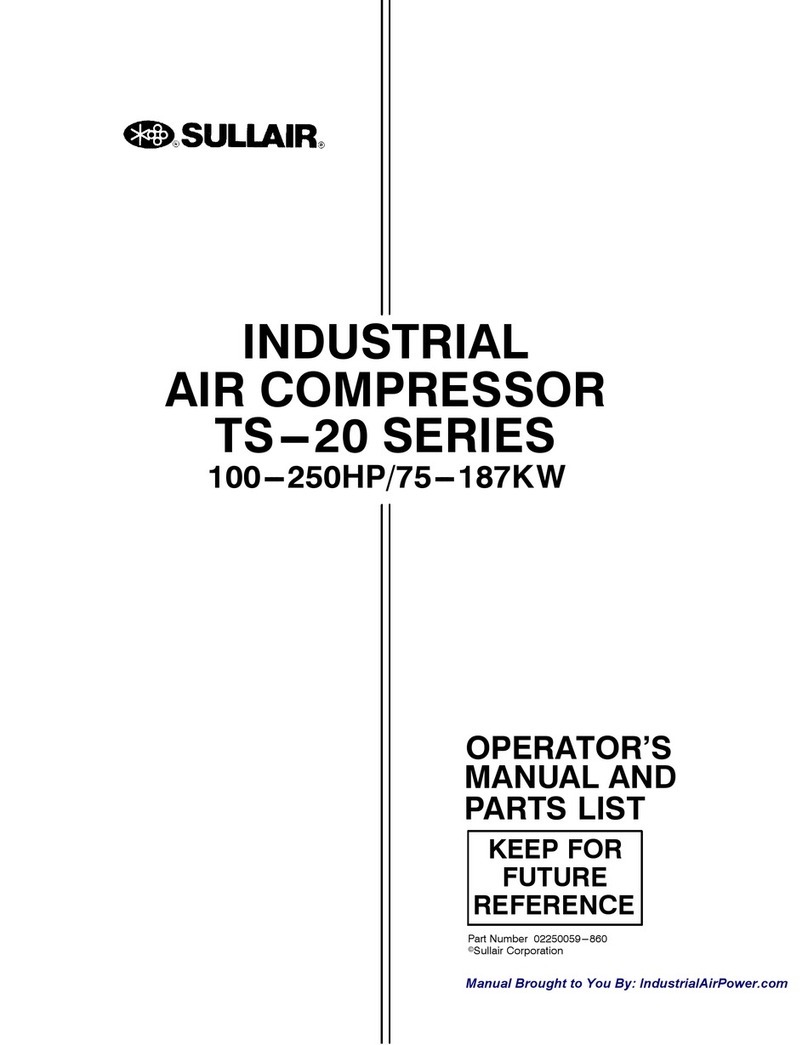
Sullair
Sullair TS-20 Operator's manual and parts list

Doosan
Doosan P600/XP535WCU-T4i Operation and maintenance manual
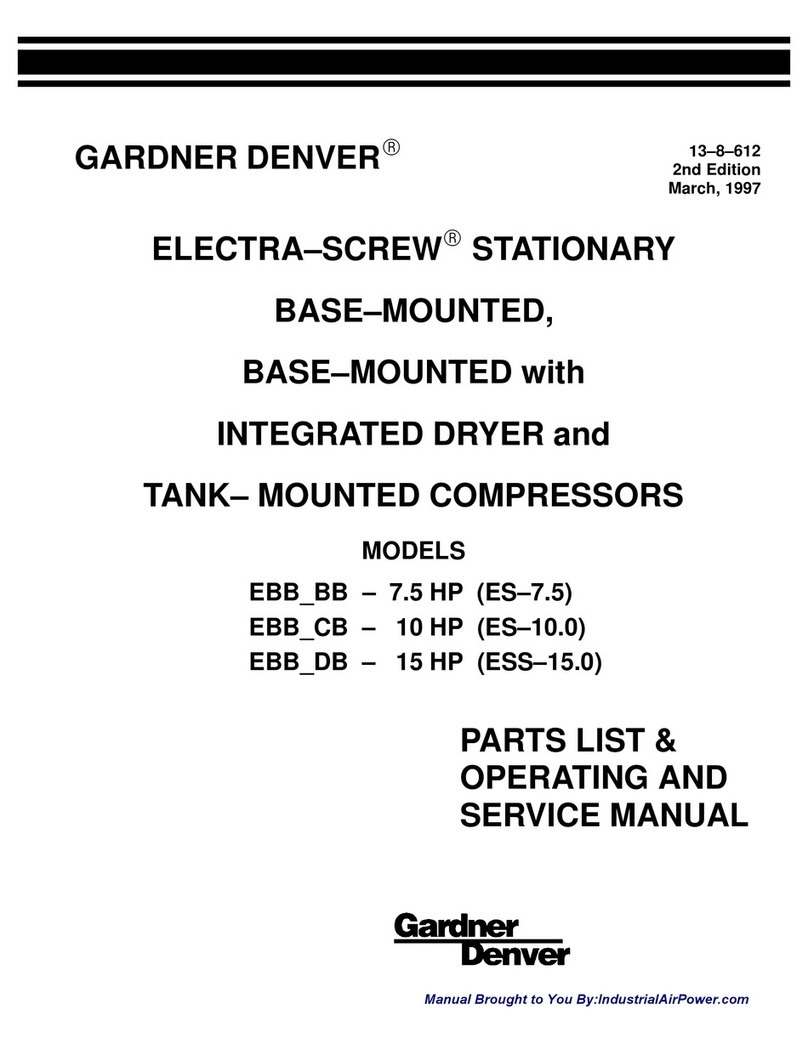
Gardner Denver
Gardner Denver EBB BB-7.5 HP Operating and service manual

Craftsman
Craftsman 919.195400 Operator's manual

ULTIMATE SPEED
ULTIMATE SPEED UMK 10 C2 Operation and safety notes translation of the original instructions
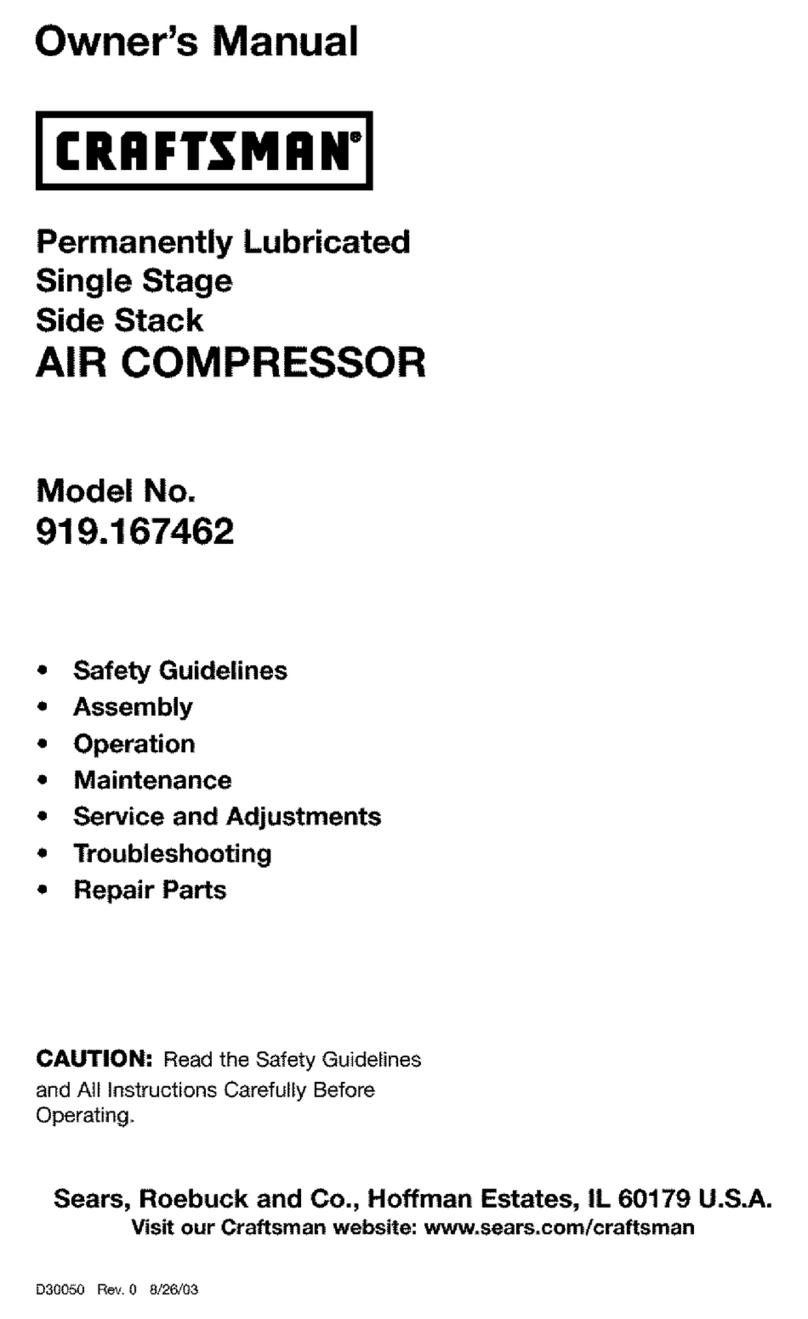
Craftsman
Craftsman 919.167462 owner's manual
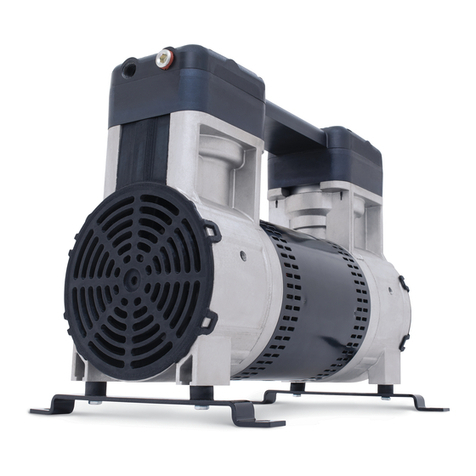
Gast
Gast 120R Operation and maintenance manual
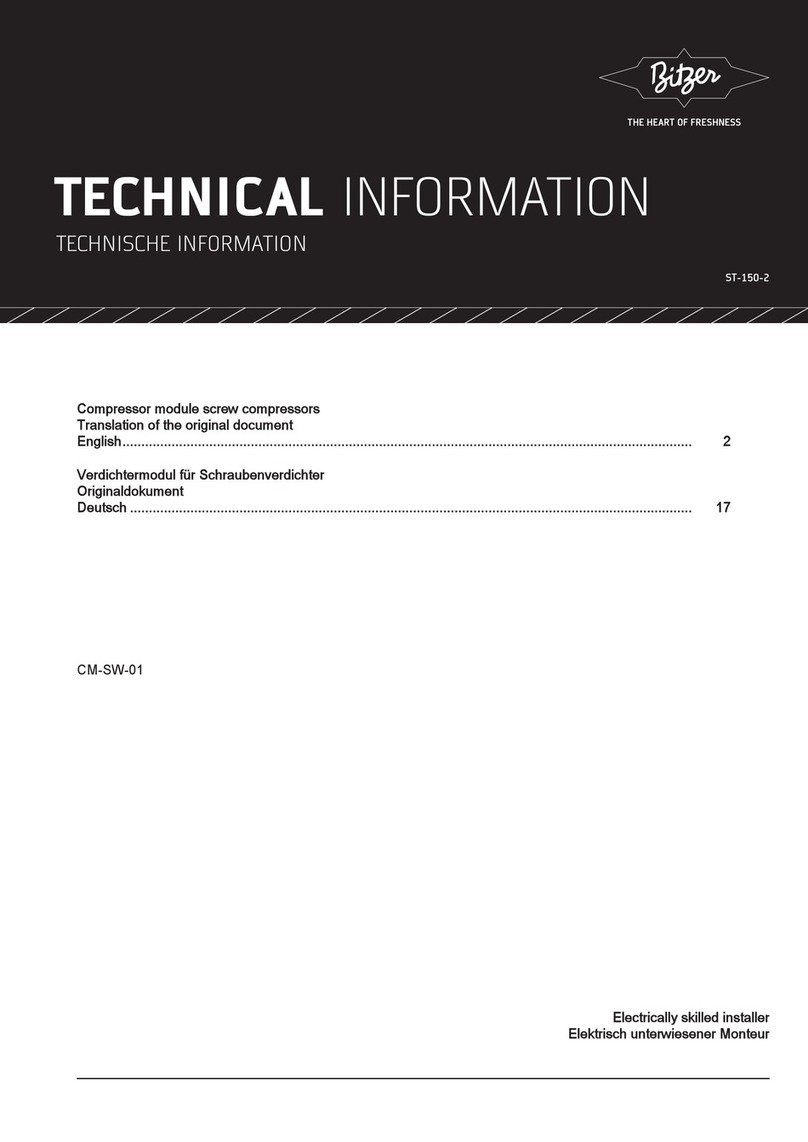
Bitzer
Bitzer ST-150-2 technical information
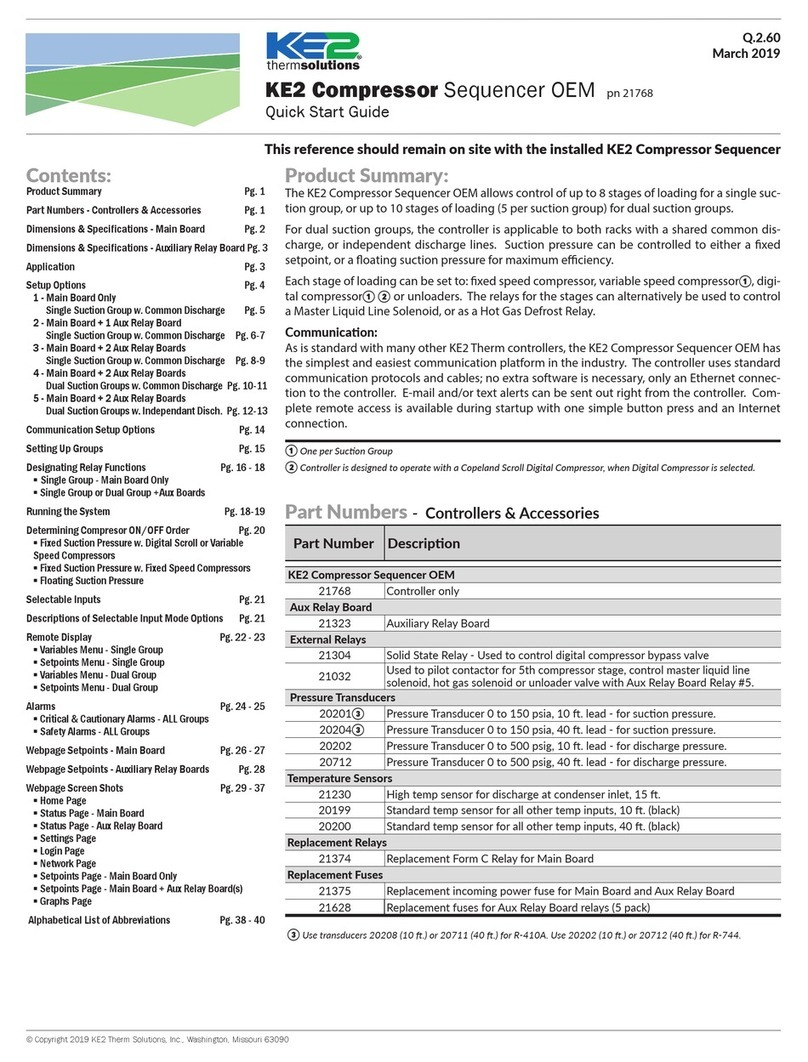
KE2
KE2 Compressor Sequencer OEM quick start guide

